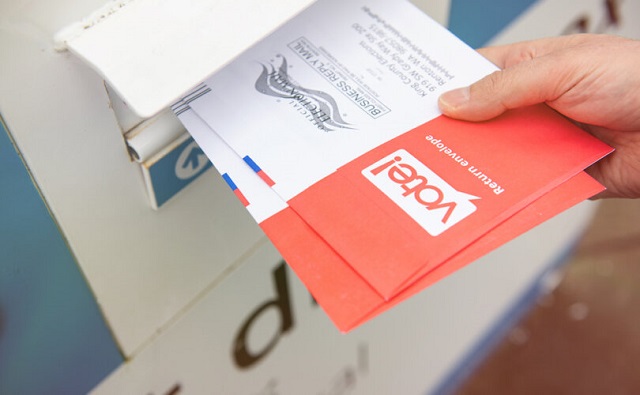Sports
Party for Barty at Australian Open; Sharapova, Kerber out

MELBOURNE, Australia — It was like a party at Rod Laver Arena. A partisan crowd backed Ash Barty, booed Maria Sharapova and celebrated wildly when the first Australian woman in a decade reached the quarterfinals at Melbourne Park.
Rod Laver was there watching, among the tennis greats. Prime Minister Scott Morrison in his green Aussie cap was cheering from the side of the court. It was in vogue for Aussies to be watching. Anna Wintour, too.
It took four match points and 2 hours, 22 minutes before Barty fended off 2008 champion Sharapova 4-6, 6-1, 6-4, reaching the quarterfinals of a major for the first time. She’s the first Australian woman since Jelena Dokic to reach the last eight at the home Grand Slam tournament. No Aussie woman has won it in 41 years.
“It’s amazing that it’s … happening in Australia,” Barty said, reflecting on her first goal for 2019. “I have given myself the opportunity and the chance to play in front of the best crowd in the world on one of the best courts in the world and in my home Slam. There is absolutely nothing better.”
She’ll next play two-time Wimbledon champion Petra Kvitova, who defeated 17-year-old American Amanda Anisimova 6-2, 6-1 in 59 minutes to return to the Australian Open quarterfinals for the first time in seven years.
Another former No. 1 and former Australian titlist quickly followed Sharapova out when Danielle Collins upset three-time major winner Angelique Kerber 6-0, 6-2.
Collins had never won a match at a Grand Slam before coming to Australia — now she’s won four straight and eliminated No. 14 Julia Goerges, No. 19 Caroline Garcia and No. 2 Kerber along the way. She’ll face either 2017 U.S. Open champion Sloane Stephens or Anastasia Pavlyuchenkova in the quarterfinals.
Sharapova won the first set but was struggling with her serve, and finished with 10 double-faults in the match. After dropping the second set — midway through Barty’s nine-game winning streak — Sharapova took an extended break in the locker room and was booed when she came back to court. That’s a rarity for the five-time Grand Slam winner in these parts.
A comeback was always on the cards, and Sharapova nearly delivered — recovering from 4-0 down in the deciding set, forcing Barty to serve it out, and saving three match points when she did.
Two seasons back from her break to pursue a career in cricket, Barty has become Australia’s best chance of producing a local champion since 1978. In her on-court interview, she saluted her former cricket team and said she’d watched on TV the previous day as they qualified for the national final.
“I needed to take that time away,” she said, reflecting on her time out playing cricket. “I feel like I came back a better person on and off the court, a better tennis player.”
Her immediate concern, though, is getting past Kvitova, who beat her in the final of the Sydney International last week.
Kvitova wanted no part of another loss to Anisimova, who beat her last year at Indian Wells and was the youngest American since Jennifer Capriati in 1993 to make it this far at Melbourne Park.
And so she went on the attack early, breaking in the first game. Kvitova was the model of consistency that the two other seeded players previously vanquished by Anisimova — No. 24 Lesia Tsurenko and No. 11 Aryna Sabalenka — were not.
Kvitova had to miss the Australian Open in 2017 because she was still overcoming injuries to her left hand that she sustained in a home invasion the previous month at her place in the Czech Republic. She lost in the first round here last year.
She’s now on a nine-match winning streak, her four wins here come after a title run in Sydney, and is into the quarterfinals here for the first time since 2012.
“When I’m counting the years, it’s pretty long,” Kvitova said. “But, you know, sometimes the waiting time is worth for it. I’m not complaining at all.”
Kvitova broke Anisimova’s serve five times and never faced a break point. She got 86
“She came out with a really solid game plan against me. That kind of threw me off — it was different from my other matches,” said Anisimova, who will go home with her first Grand Slam match wins to her credit, and a much higher profile. “I was hoping that I’d just win a first-round match, so getting this far means a lot to me.”
Frances Tiafoe celebrated his 21st birthday with a spot in his first major quarterfinal, beating No. 20-seeded Grigor Dmitrov 7-5 7-6 (6), 6-7 (1), 7-5. The American took off his shirt, flexed his right bicep and waved to the crowd on Melbourne Arena.
After beating the likes of No. 5 Kevin Anderson and Dmitrov, the road ahead gets significantly tougher for Tiafoe. He next plays No. 2-seeded Rafael Nadal, the 17-time major winner who didn’t let Tomas Berdych on the scoreboard for 1
Nadal beat Australians in the first three rounds and then dominated a long-time rival, winning the first nine games before the 2010 Wimbledon finalist finally held serve and held up his left fist in mock celebration.
“When you’re back, you need a little bit of the luck in the beginning,” said Nadal, who didn’t play a competitive match between the last U.S. Open and the season-opening major in Australia because of injuries. “I’m in the quarterfinals, let’s see what happens now.”
In other action, Canadian Gabriela Dabrowski and partner Mate Pavic of Croatia, who are ranked No. 1 and the defending mixed doubles champions at the Australian Open, are moving on.
The 26-year-old from Ottawa and Pavic toppled the Australian duo of Priscilla Hon and Alexei Popyrin in first-round action 6-3, 6-3.
___
More AP Tennis: https://www.apnews.com/apf-Tennis and https://twitter.com/AP_Sports
John Pye, The Associated Press
Bruce Dowbiggin
Coyotes Ugly: The Sad Obsession Of Gary Bettman

It came to this. Playing in the 6,000 seat Mullet Arena on the campus of Arizona State. Owned by a luckless guy who eschewed the public spotlight. Out of the playoffs, their bags packed for who knows where, the Arizona (née Phoenix) Coyotes gave an appreciative wave to the tiny crowd gathered to say Thanks For The Memories.
With that they were history. Although NHL commissioner-for-life Gary Bettman has promised the last in a set of hapless owners that he can revive the franchise for a cool billion should he build the rink that no one was willing to build for the Yotes the past 20 years.
The Arizona Republic said good riddance. “Metro Phoenix lost the Coyotes because we are an oversaturated professional and college sports market with an endless supply of sunshine and recreational choices. Arizona may have dodged a slapshot:
We have the NFL Cardinals, the MLB Diamondbacks, the NBA Suns, MLB spring training, the WM Phoenix Open, the Phoenix Rising, the WNBA Mercury, the Indoor Football League Rattlers and the Arizona State Sun Devils. There hasn’t been a household name on the Coyotes since Shane Doan, and half of Phoenix probably doesn’t know who he was”.
Likely they’ll be a financial success in Salt Lake City where there’s a viable owner, lots of money and a will to make it work. They’ll need a will because— stop me if you’ve heard this before about the Coyotes— the rink they’ll play in this fall has only 12,500 unobstructed views for hockey.
Watching this farce we recalled getting a call from Blackberry co-founder Jim Balsillie in 2008, shortly after our book Money Players was a finalist for the Canadian Business Book of The Year. We’d written a fair bit about the Coyotes in our work and someone had told Balsillie we might be the ones to talk to about a plan he was concocting to buy the bankrupt Coyotes and eventually move them to Hamilton.

Balsillie was salty over the way he’d been used as a stalking horse in the financial troubles of the Pittsburgh Penguins in 1990s. Flush with money from the huge success of RIM, Balsillie offered to buy the Pens, with an eye to moving them to southern Ontario if Pittsburgh didn’t help build a new arena for the team.
In time, Balsillie saw that Bettman was only trying to protect the investment Mario Lemieux and others had in the Pens. Balsillie was the black hat who eventually spooked Pittsburgh into giving the current owners what they wanted. At the end of the day, Mario got his money and Balsillie was given a “thanks for trying”: parting gift of nebulous promises.
Still smarting, Balsille vowed not to be used again. in his desire to bring the NHL to southern Ontario. So when the Coyotes owner Jerry Moyes threw the keys to the team on Bettman’s desk, he saw an opening in the bankruptcy that followed. Seeing Bettman as the impediment, Balsillie decided to buy the team out of bankruptcy, a process the NHL could not legally prevent.
What Balsillie wanted to know was “What then? How would Bettman fight back?” We told him that no one flouts Bettman’s authority within the NHL. (All the current owners since 1993 have come aboard on his watch.) And that he’d have to get the Board of Governors to approve his purchase. Odds: Nil.
That’s what happened. Rather than admit that the Valley of the Sun was poisoned for hockey, Bettman found another series of undercapitalized marks to front the franchise while the league quietly propped up the operation. No longer was the Coyotes’ failure about the fans of Arizona. It was about Gary Bettman’s pride.

Protestors stand outside a press conference in Tempe featuring Arizona Coyotes executives discussing propositions related to a new arena and entertainment district. (Photo by Brooklyn Hall/ Cronkite News)
Where he had meekly let Atlanta move to Winnipeg he fought like hell to save Arizona. And his power. (His obstinacy on U.S. network TV is another story.)
Fast forward to last week and the abject failure of that process. The Arizona Republic naively fawned on Bettman for his many attempts to save the team. In fact, they were just attempts to buttress his grip on the league. While the Coyotes may have been a mess, Bettman has succeeded in preserving the investments of most of the business people who bought his NHL business prospectus.
Sometimes it meant riding into Calgary to chastise the locals for their parsimony in not giving the Flames a new rink. Ditto for Edmonton. Ditto for Winnipeg and other cities. Other times it was to shore up weak partners to protect the equity of other prosperous cities. Sometimes it was to tell Quebec City, “Not gonna’ happen.”
For his loyalty to the owners and through some luck— Gretzky to the Kings— Bettman has made the NHL work in places no one might’ve imagined. Nashville. Raleigh. Tampa. Las Vegas. Dallas. Not at the level of the NFL, NBA or MLB, but at a comfortable equity-affirming status. Nothing happens without his say-so in the NHL. Or without him getting credit. Secondary NHL execs who wanted credit for their innovations were quietly punted.
When Houston finally gets a franchise from Gary they’ll part with $1.5 billion for the honour. While the commissioner has played down new franchises and expanded playoffs, you can bet your last dollar that he’s told owners they’re in line for more expansion cash— cash they don’t have to split with players in collective bargaining.
One more certainty. As long as Bettman rules the NHL you won’t see an NHL team back in Arizona.
Bruce Dowbiggin @dowbboy is the editor of Not The Public Broadcaster A two-time winner of the Gemini Award as Canada’s top television sports broadcaster, he’s a regular contributor to Sirius XM Canada Talks Ch. 167. Inexact Science: The Six Most Compelling Draft Years In NHL History, his new book with his son Evan, was voted the seventh-best professional hockey book of all time by bookauthority.org . His 2004 book Money Players was voted sixth best on the same list, and is available via brucedowbigginbooks.ca.
Opinion
Female athletes are turning against gender-confused men dominating women’s sports

From LifeSiteNews
If female athletes came together and demanded, with one voice, that female sports be protected, they would be pushing at an open door.
What happens when obvious truths about the differences between the sexes are denied by the elites at the behest of the transgender movement? And what happens when female athletes discover that their rights mean less than the newly invented “rights” of trans-identifying men to invade their spaces?
We’ve seen the answer to that play out over the past few years. This month alone, a trans-identifying male beat his female competitors at an Oregon track meet by a full six seconds, with the video of him zipping across the finish line sparking outrage; a trans-identifying marathon runner announced that he will be competing in the full set of six marathon majors in Boston in the male, female and “non-binary” categories; and courts in West Virginia and Ohio ruled that trans-identifying males can compete on female sports teams.
In the meantime, U.K. culture secretary Lucy Frazer called for a ban on males in female sports after meeting with representatives of a number of female sports leagues, writing:
In competitive sport, biology matters. And where male strength, size and body shape gives athletes an indisputable edge, this should not be ignored. By protecting the female category, they can keep women’s competitive sport safe and fair and keep the dream alive for the young girls who dream of one day being elite sportswomen.
She concluded, “We must get back to giving women a level playing field to compete. We need to give women a sporting chance.” Refreshingly, she called on sporting bodies to take an “unambiguous position” on the matter.
That, of course, is common sense. What makes Frazer’s statements significant is that she does not, like most politicians trying to thread the needle by accepting transgender ideology but rejecting the inevitable conclusions thereof, make multiple references to “transgender women.” She instead refers to keeping male bodies out of female sports, much to the outrage of trans activists, who insist that males who identify as females are females, and thus have female bodies, because they said so.
Over the past several years, it has fallen largely to the few female sportswomen who dared to risk the opprobrium of the LGBT movement to speak for the majority and point out the unfairness of allowing males to invade their sporting domains; now, an increasing number are willing to speak out. A recent study conducted by Manchester Metropolitan and Swansea universities, published April 17 in the Journal of Sports Sciences, indicates that the majority of female athletes want women’s sports to be categorized by sex rather than “gender identity.”
Fifty-eight percent of respondents in the study of elite female athletes wanted categorization by biological sex; that rose to 77 percent among those classified as “world-class athletes” who had competed in Olympic or world championship finals. Researchers surveyed 175 “national, elite and world class female athletes – current and retired – from a range of sports and countries” and included “26 world champions, 22 Olympians and six Paralympians,” making it the largest study of its kind conducted thus far. A BBC Sports study last month found that over 100 elite U.K. female athletes “would be uncomfortable” with trans-identifying males competing in the female categories of their sports.
According to the study, there is one exception to the rule: the “majority of athletes competing in non-Olympic sports believe changing category should be allowed, with the highest rate of 74% among those in ‘precision’ sports such as archery.”
In short, the higher female athletes climb, the more likely they are to object to trans-identifying males competing in their categories. Most of these athletes, of course, remain unnamed. Imagine if they came out together and demanded, with one voice, that female sports be protected. It would constitute a cultural sea change – and I suspect the moment is right for them to do so. If they pushed, they would be pushing at an open door.
-

 Business1 day ago
Business1 day agoHonda deal latest episode of corporate welfare in Ontario
-

 espionage1 day ago
espionage1 day agoOne in five mail-in voters admitted to committing voter fraud during 2020 election: Rasmussen poll
-

 Automotive1 day ago
Automotive1 day agoThe EV ‘Bloodbath’ Arrives Early
-

 CBDC Central Bank Digital Currency16 hours ago
CBDC Central Bank Digital Currency16 hours agoA Fed-Controlled Digital Dollar Could Mean The End Of Freedom
-

 Brownstone Institute14 hours ago
Brownstone Institute14 hours agoThe Numbers Favour Our Side
-

 Frontier Centre for Public Policy11 hours ago
Frontier Centre for Public Policy11 hours agoHow much do today’s immigrants help Canada?








